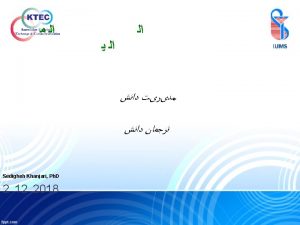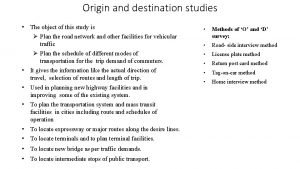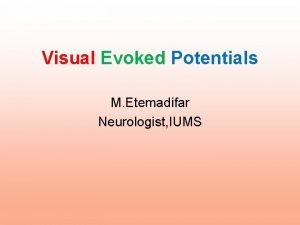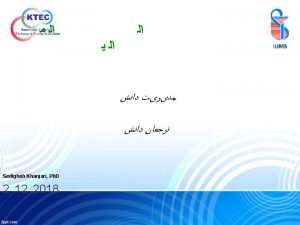IUMS 2017 1178 A study on the origin








![Genomic constellations of G 6 P[9] rotavirus (KF 17) and prototype strains (Numazaki and Genomic constellations of G 6 P[9] rotavirus (KF 17) and prototype strains (Numazaki and](https://slidetodoc.com/presentation_image_h2/8a040e2a52ccf80f55c86b1375be1086/image-9.jpg)
![Phylogenetic analysis of VP 7 genes of G 6 P[9] (M 72 S 11) Phylogenetic analysis of VP 7 genes of G 6 P[9] (M 72 S 11)](https://slidetodoc.com/presentation_image_h2/8a040e2a52ccf80f55c86b1375be1086/image-10.jpg)
![Phylogenetic analysis of VP 4 genes of G 6 P[9] (M 72 S 11) Phylogenetic analysis of VP 4 genes of G 6 P[9] (M 72 S 11)](https://slidetodoc.com/presentation_image_h2/8a040e2a52ccf80f55c86b1375be1086/image-11.jpg)



- Slides: 14

IUMS 2017 -1178 A study on the origin of bovine rotavirus strains detected from the children of the Nasu district, Tochigi, Japan Kei Numazaki, MD, Ph. D Division of International Infectious Diseases, Graduate School International University of Health and Welfare Nasu-shiobara, Tochigi, Japan

No commercial relationship or potential conflict of interest related to this presentation

Background Serious gastrointestinal infection of rotavirus (RV) is usually prevalent during winter months and often seen in infants and young children. While at least 11 G genotypes have been isolated from humans, G 1, G 2, G 3, G 4, and emerging G 9 are major genotypes of human RV. Although G 6 human rotavirus is quite rare, it is the major type among rotaviruses from cattle. In a study of Japanese cows, 59. 1% of isolates belonged to G 6. Usually, bovine G 6 strains were combined with P[5], P[1], and P[11] worldwide. Studies on genotypes of prevalent RV strains are quite important for preventing infection, developing vaccines, and its evaluation. We investigated the characteristics of RV infections of the Nasu district of Tochigi, Japan and to compare to the other region before introduction of rotavirus vaccines.

Materials and Methods We examined the clinical findings in 147 patients who attended to the Department of Pediatrics at International University of Health and Welfare Hospital in Nasu-shiobara City, Tochigi, Japan during the time of April 1, 2008 to March 31, 2010. We analyzed the clinical findings of the 37 patients with a fecal sample positive for RV antigen on VP 6, NSP 4 gene RT-PCR genotyping. Viral genotypes Nasu-Shiobara were determined using Tochigi rotavirus-positive samples from 27 of these 37 patients.

Results In 37 cases in VP 6, NSP 4 gene-based RT-PCR 24 samples were positive and the genotypes were determined as G 1 P [8] in 5 samples, G 3 P [8] in 5 samples, G 9 P [8] in 3 samples, and G 6 P [9] in 2 samples. Of particular note, we detected G 6 P [9] which were extremely rare in human beings but common in cattle. KF 17 strain of a patient showed G 6 type of bovine strains and P [9] was admitted to reconcile with human strains. Per match ratio in each gene of VP 6, VP 1, VP 2, VP 3, and NSP 4 showed a high match rate (84. 1 -86. 4%) with DS-1 type. Per match ratio in each gene of VP 4, NSP 1, NSP 3, NSP 4 and NSP 5 also showed a high match rate (94. 2 -96. 9%) with AU-1 type. Bovine type strain gene segments become reassortant rotaviruses major two genes in these stocks.

Summary of genotypes of rotavirus A (RVA) Viral proteins Genotypes Common Genotypes in Human VP 7 G G 1, G 2, G 3, G 4, G 9, G 12 VP 4 P P[4], P[6], P[8] VP 6 I I 1, I 2 VP 1 R R 1, R 2 VP 2 C C 1, C 2 VP 3 M M 1, M 2 NP 1 A A 1, A 2 NP 2 N N 1, N 2 NP 3 T T 1, T 2 NP 4 E E 1, E 2 NP 5 H H 1, H 2


Phylogenetic trees of the VP 7 gene segments of the KF 17 strain from Case 24 VP 7 genes
![Genomic constellations of G 6 P9 rotavirus KF 17 and prototype strains Numazaki and Genomic constellations of G 6 P[9] rotavirus (KF 17) and prototype strains (Numazaki and](https://slidetodoc.com/presentation_image_h2/8a040e2a52ccf80f55c86b1375be1086/image-9.jpg)
Genomic constellations of G 6 P[9] rotavirus (KF 17) and prototype strains (Numazaki and Ichikawa, 2014).
![Phylogenetic analysis of VP 7 genes of G 6 P9 M 72 S 11 Phylogenetic analysis of VP 7 genes of G 6 P[9] (M 72 S 11)](https://slidetodoc.com/presentation_image_h2/8a040e2a52ccf80f55c86b1375be1086/image-10.jpg)
Phylogenetic analysis of VP 7 genes of G 6 P[9] (M 72 S 11) Infectious Agents Surveillance Reports IASR Vol. 35 p. 298 - 300: 2014
![Phylogenetic analysis of VP 4 genes of G 6 P9 M 72 S 11 Phylogenetic analysis of VP 4 genes of G 6 P[9] (M 72 S 11)](https://slidetodoc.com/presentation_image_h2/8a040e2a52ccf80f55c86b1375be1086/image-11.jpg)
Phylogenetic analysis of VP 4 genes of G 6 P[9] (M 72 S 11) Infectious Agents Surveillance Reports IASR Vol. 35 p. 298 - 300: 2014

Distribution and genotypes of feline rotaviruses isolated from all FRV-positive Cats Protection Adoption Centers in the United Kingdom during 2012 German, AC et al. J. Clin. Microbiol. February 2015 vol. 53 no. 2 455 -464 No. with genotype a Center Birmingham Bridgend Chelmsford Derby Downham Market Exeter Axhayes Glasgow Haslemere Isle of Wight G 6 P[9] 9 G 6 P[X] 4 G 3 P[9] G 3 P[X] GXP[9] 2 1 2 GXP[X] 3 2 2 1 3 1 Mansfield NCAC Nottingham Truro 2 18 Total FRVs 11 5 2 1 21 a X indicates G or P rotavirus genotypes that were unable to be elucidated. Total no. of positives 18 3 2 1 1 1 1 2 1 17 1 1 2 21 57

Molecular Epidemiology of Rotavirus in Cats in the United Kingdom German, AC et al. J. Clin. Microbiol. February 2015 vol. 53 no. 2 455 -464 • Two G and P genotype combinations, G 3 P[9] and G 6 P[9], were identified carried by RV circulating in cats population in the United Kingdom in 2012, • G 3 P[9] is a recognized feline genotype (AU-1 -like and BA 222 -like genotype constellations). • G 6 was the more prevalent genotype (84%) and was detected in Scotland, the Midlands, and Cornwall. • Both G 3 P[9] and G 6 P[9] genotypes have been isolated from people in other parts of the globe. • It was strongly suggested that G 6 P[9] genotypes are examples of zoonotic or anthropozoonotic transmission between cats and people

Discussion and Conclusion In the phylogenetic analysis the gene of a strain KF 17 of G 6 P [9] was located in a human lineage including other human G 6 strains. Similarly, all other genes of the strain except for the NSP 3 gene were relatively closely related to at least one of the human G 6 RVs reported in Europe and the U. S. In a study in Miyagi Prefecture G 6 P [9] (M 72 S 11) per sample was found from a 2 -year-old toddler in 2011. Also G 6 P [9] have been detected from more than 3 cats of Mie Prefecture. These findings suggest that human G 6 RVs which had occurred by reassortment between human and bovine RVs are distributed worldwide, despite low prevalence. G 6 RV may occur independently in different areas through reassortment among local strains.
 Iums چیست
Iums چیست Finalidades de la ley 1178
Finalidades de la ley 1178 Responsabilidad penal ley 1178
Responsabilidad penal ley 1178 Faltas y sanciones
Faltas y sanciones Tipos de responsabilidad de la ley 1178
Tipos de responsabilidad de la ley 1178 Methods of origin and destination study
Methods of origin and destination study Hát kết hợp bộ gõ cơ thể
Hát kết hợp bộ gõ cơ thể Slidetodoc
Slidetodoc Bổ thể
Bổ thể Tỉ lệ cơ thể trẻ em
Tỉ lệ cơ thể trẻ em Gấu đi như thế nào
Gấu đi như thế nào Glasgow thang điểm
Glasgow thang điểm Hát lên người ơi alleluia
Hát lên người ơi alleluia Môn thể thao bắt đầu bằng từ chạy
Môn thể thao bắt đầu bằng từ chạy Thế nào là hệ số cao nhất
Thế nào là hệ số cao nhất























